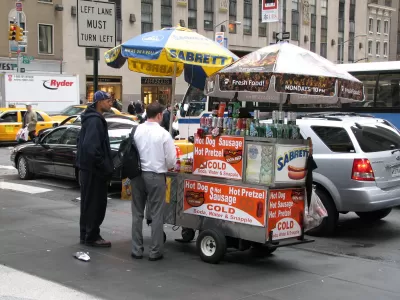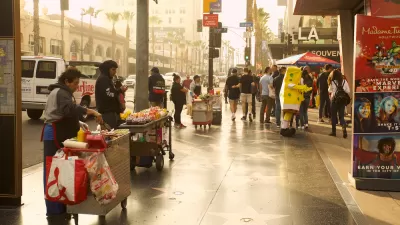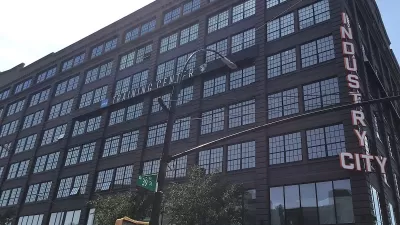Despite operating on public right-of-way, food vendors claim that developers are pushing them out of established vending spots.

New York's street vendors are mounting a campaign against displacement by real estate interests, writes Valeria Ricciulli in Curbed. "It is time that the real estate industry stopped running our city and controlling our public space," says Mohamed Attia, executive director of the Street Vendor Project.
Hot dog vendor Mohamed Awad has watched his business in the Hudson Yards get slowly eaten away by real estate interests. When Hudson Yards opened in 2019, "Awad, his partners, and their employees began to face harassment from the police and Hudson Yards security, even though their carts are on a public sidewalk." To make matters worse, property owner Related has added landscaping elements that the vendors see as a purposeful attempt to "push them out of Hudson Yards altogether." Awad explained that since "city regulations explicitly require vendors to leave a 12-foot-wide clear path on the sidewalk in front of their carts," the landscaping additions "effectively built him out of business."
"After their rally, several street vendors took it upon themselves to push back, literally. The Street Vendor Project had found that Related didn’t have a DOT permit to set out that planter. So several street vendors worked together to shove it just far enough to make room for Awad’s cart, as Hudson Yards employees and several NYPD officers stood by."
Days later, the planter had been moved back. Awad is undeterred. "I’ve been here before all of them," he said. "It doesn’t mean I own [the space], but this is a public street. I’m not going to give up."
FULL STORY: Hudson Yards Has Landscaped Out the Food Vendors

Manufactured Crisis: Losing the Nation’s Largest Source of Unsubsidized Affordable Housing
Manufactured housing communities have long been an affordable housing option for millions of people living in the U.S., but that affordability is disappearing rapidly. How did we get here?

Americans May Be Stuck — But Why?
Americans are moving a lot less than they once did, and that is a problem. While Yoni Applebaum, in his highly-publicized article Stuck, gets the reasons badly wrong, it's still important to ask: why are we moving so much less than before?

Using Old Oil and Gas Wells for Green Energy Storage
Penn State researchers have found that repurposing abandoned oil and gas wells for geothermal-assisted compressed-air energy storage can boost efficiency, reduce environmental risks, and support clean energy and job transitions.

San Antonio Remains Affordable as City Grows
The city’s active efforts to keep housing costs down through housing reforms and coordinated efforts among city agencies and developers have kept it one of the most affordable in the nation despite its rapid population growth.

What Forest Service Cuts Mean for Cities
U.S. Forest Service employees work on projects that have impacts far beyond remote, rural wilderness areas.

North Texas Transit Leaders Tout Benefits of TOD for Growing Region
At a summit focused on transit-oriented development, policymakers discussed how North Texas’ expanded light rail system can serve as a tool for economic growth.
Urban Design for Planners 1: Software Tools
This six-course series explores essential urban design concepts using open source software and equips planners with the tools they need to participate fully in the urban design process.
Planning for Universal Design
Learn the tools for implementing Universal Design in planning regulations.
Heyer Gruel & Associates PA
City of Moreno Valley
Institute for Housing and Urban Development Studies (IHS)
City of Grandview
Harvard GSD Executive Education
Salt Lake City
NYU Wagner Graduate School of Public Service
City of Cambridge, Maryland





























